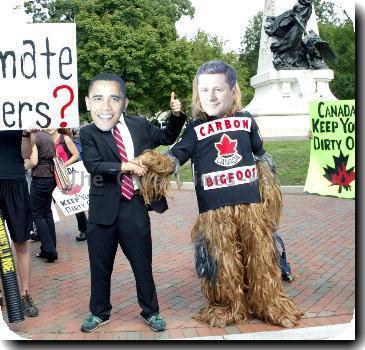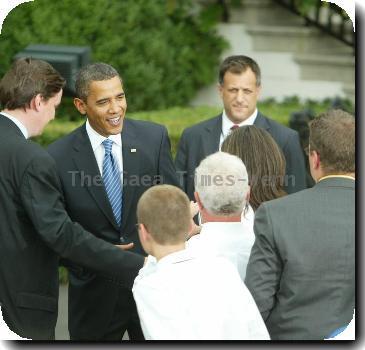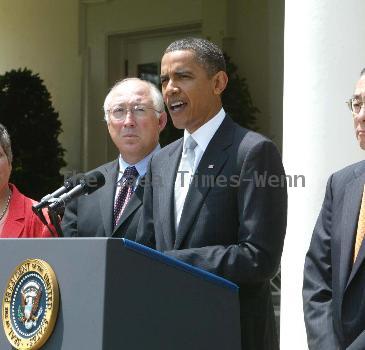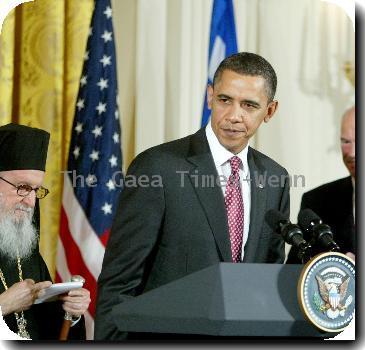Americans watch, wait to see if latest attempt to plug Gulf oil well works
By Greg Bluestein, APFriday, May 28, 2010
Oil spill cam becomes Internet sensation
ROBERT, La. — The hypnotic video of mud, gas and oil billowing from the seafloor has become an Internet sensation as Americans watch to see whether BP’s effort to plug the gusher in the Gulf of Mexico succeeds.
BP warned Friday that it could be Sunday or later before the outcome of the cliffhanger becomes clear. And scientists cautioned that few conclusions can be drawn with any certainty from watching the spillcam coverage of the “top kill.” But some said the video seemed to suggest BP was gaining ground.
In an operation that began Wednesday, BP has been pumping heavy drilling mud into the blown-out well in hopes of choking it off and putting an end to what is already the biggest oil spill in U.S. history, at anywhere from 18 million gallons to 40 million by the government’s estimate.
Coast Guard Adm. Thad Allen said the denser-than-water mud was able to push down the oil and gas coming up at great force from underground, but it had not overwhelmed the gusher. The trick is to pump the mud with such force that it stops the upward flow of oil, and it’s impossible to know how much mud that will take.
BP chief operating officer Doug Suttles said Friday the top kill was going basically as planned, though the pumping has stopped several times.
“The fact that it’s stopped and started is not unusual,” Suttles said. “We’re going to stay at this as long as we need to.”
He said the company has also shot in assorted junk, including metal pieces and rubber balls, which seemed to be helping to counter pressure from the well.
A top kill has never been attempted 5,000 feet underwater, and public fascination is high.
BP, under pressure from Congress, made available a live video feed of what is going on underwater, and about 3,000 websites were showing a version of it that the PBS “Newshour” offered for free. On Thursday alone, show spokeswoman Anne Bell said, more than a million people watched it. Many found it hypnotic.
“It made me wonder how I use energy and if this situation could teach us how much energy we use ourselves,” said Jeb Banner, 38, a web design and marketing company owner in Indianapolis who has been looking at the feed every hour or so since before the top kill started. “It felt like a historic moment.”
It was difficult to tell sometimes how the top kill was going. On Friday, reporters received a note from a BP spokesman saying information on it is now considered “stock-market sensitive” and updates can be provided only in “formal settings,” though BP’s CEO talked about it on the morning news shows.
Meanwhile, President Barack Obama visited the coast to see the damage as he tried to emphasize that his administration was in control of the crisis, which began April 20 when the Deepwater Horizon drilling platform blew up. Eleven workers were killed.
“I’m here to tell you that you are not alone, you will not be abandoned, you will not be left behind,” he told people in Grand Isle, where the beach has been closed by gobs of oil and the frustration and anger are palpable. “The media may get tired of the story, but we will not. We will be on your side and we will see this through.”
Hundreds of workers hit the beaches ahead of Obama’s visit, cleaning debris from the shoreline before they hopped on buses and left soon after the president arrived.
“This is the cleanest I’ve ever seen the beach,” Louisiana Gov. Bobby Jindal said. “We saw a surge of activity the last couple of days. Let’s hope it continues now that he’s gone.”
Watching the video could offer clues to who is winning in the battle — BP or the oil — said Tony Wood, director of the National Spill Control School at Texas A&M University in Corpus Christi. If the stuff coming out of the pipe is jet black, it is mostly oil and BP is losing. If it is whitish, it is mostly gas and BP is also losing.
If it is muddy brown, as it was Friday, that may be a sign that BP is starting to achieve success, he said. That “may in fact mean that there’s mud coming up and mud coming down as well,” which is better than oil coming out, Wood said.
Philip W. Johnson, an engineering professor at the University of Alabama, said the camera appeared to show mostly drilling mud leaking from the well Friday morning, and two of the leaks appeared a little smaller than in the past, suggesting the top kill “may have had a slight but not dramatic effect.”
But Bob Bea, a professor of engineering at University of California at Berkeley who has studied offshore drilling for 55 years, said late Friday that what he saw didn’t look promising.
He likened the effort to trying to push food into a reluctant baby’s mouth — it only works if the force of the stuff going down is more than the force of what’s coming up.
“It’s obvious that the baby’s spitting the baby food back” because the pressure pushing up from the well is stronger, Bea said.
BP has brought in about 2.5 million gallons of drilling mud for the top kill. The first infusion of junk to clog up the well was Thursday evening.
BP CEO Tony Hayward said Friday morning the effort was progressing as planned and had a 60 to 70 percent chance of success, the same odds he gave before the maneuver.
“Clearly I’m as anxious as everyone in America is to get this thing done,” he said.
BP says the best way to stop the oil for good is a relief well, but it won’t be complete until August. The company had been drilling a second relief well as a backup — Obama said Thursday his administration pushed for it in case the first one did not stop the oil — but work on that has stopped while the rig that had been drilling it works on another option for stopping the oil.
“We actually started that well before this job started, so you shouldn’t read that as any indication of anything about the top kill job,” BP’s Suttles said Friday.
Billy Ward, a developer who was building a gated fishing community that is now on hold because of the spill, said that Obama’s visit was for show and that there was really nothing the president could do.
“It’s the unknown that’s killing us,” said Ward, who comes to Grand Isle with his family every weekend to stay in their beach house. “We don’t know if it’s going to be six months or six years before we get back to normal, if ever. All we can do is pray.”
Online: www.deepwaterhorizonresponse.com/go/site/2931/
Associated Press Writers Seth Borenstein, Jonathan Landrum, Brian Skoloff and David Bauder contributed to this report.
Tags: Accidents, Barack Obama, Coastlines And Beaches, Covington, Energy, Environmental Concerns, Louisiana, North America, Oil spill, Robert, United States






